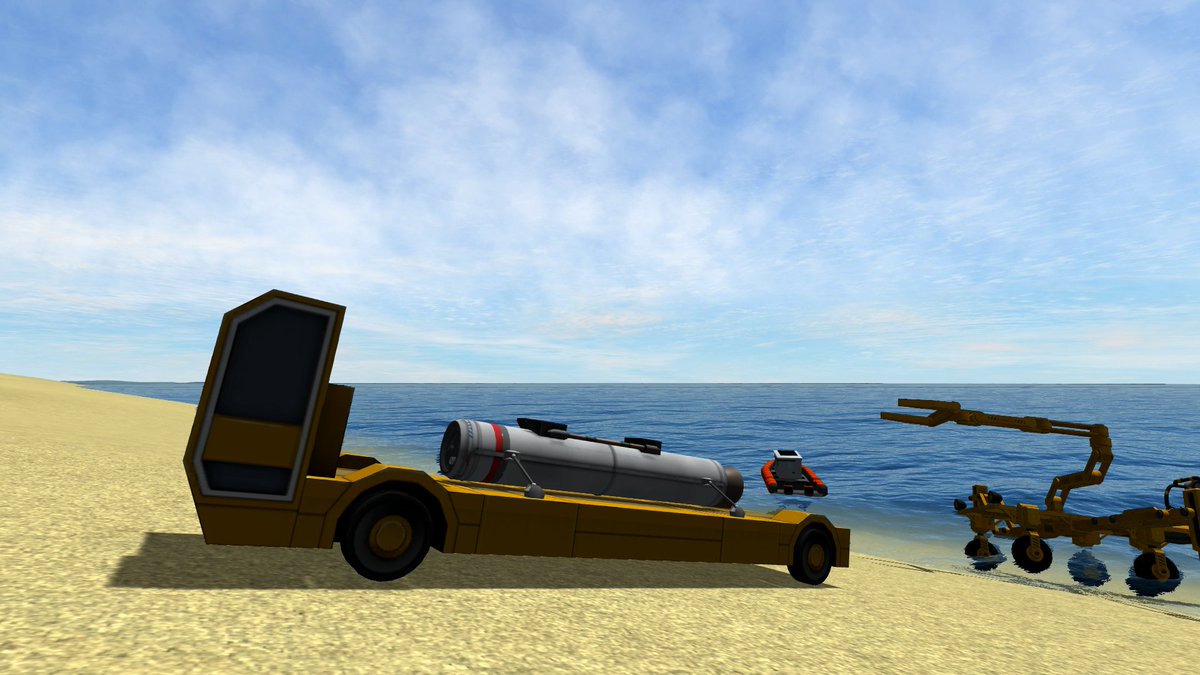 Engineers on the Progenitor team have spent the past week carefully analyzing telemetry data not only for the most recent fourth flight of the Mk5 Block I but as well for the entire series of Block I flights. The second flight of the Block I especially was of interest given that it reached nearly the same height and followed a much different trajectory. As usual, we will take a look at the details of the fourth flight first and then move on to the comparative analysis that leads to decisions made for the future of the Progeny rockets.
Engineers on the Progenitor team have spent the past week carefully analyzing telemetry data not only for the most recent fourth flight of the Mk5 Block I but as well for the entire series of Block I flights. The second flight of the Block I especially was of interest given that it reached nearly the same height and followed a much different trajectory. As usual, we will take a look at the details of the fourth flight first and then move on to the comparative analysis that leads to decisions made for the future of the Progeny rockets.
The Flight
After the numerous delays, the rocket lifted off from the launch pad at precisely 10:00:00.03 local time, soaring up into mostly-clear skies on its first stage 0.625m booster pumping out an initial thrust of 67.2kN for a TWR of 4.02. The nose pitched up only 1.4° before beginning to fall as the rocket tracked eastward away from the Kerbal Space Center. The first stage booster’s thrust profile began to reduce thrust 5 seconds after ignition, relieving stress on the rocket as it continued to climb and passed through a maximum dynamic pressure (MaxQ) of 77.371kPa at L+17.79 seconds. The booster thrust tailed off to just 17.3kN by the time propellant ran out at L+33.67 seconds at an altitude of 14.4km – it was decoupled cleanly one second later and the fins were shredded properly one second after that while the rest of the rocket coasted into the upper atmosphere.
The coast period lasted until the nose of the rocket dropped 1.5° and the second stage booster was lit off at L+46.69 seconds at an altitude of 22km with 14.7kN of force for a TWR of 3.25 (the expected ignition point was 20km for a TWR of 3). During the second stage boost at L+59.29 seconds the rocket’s apokee passed 70km and shortly afterwards at L+59.87 seconds the second stage booster was spent. After 1 second to allow for thrust to tail off completely the booster was cleanly separated from the third stage and one second later as the fins were shredded the third stage was ignited.
Although the third flight analysis specified the third stage booster would throttle initially to a TWR of 3 to help the rocket remain stable, it was reduced because the third stage would not be coasting and the second stage should not be getting knocked off prograde by the first stage. So, with the rocket already more stable than the previous flight, a lower initial TWR of 2.5 was programmed for the third stage throttle at ignition. Regardless, the rocket was already high enough in the atmosphere that it was able to throttle up to full thrust immediately without increasing dynamic pressure. The booster exhausted its fuel after 33.22 seconds, pushing the rocket’s apokee out to a record-setting 546.463km.
The long 18m52s trip up to apokee and back down to the edge of the atmosphere was uneventful, with controllers keeping a close eye on battery consumption rates and radiation levels. While the previous flight saw an average consumption of 130 watts during its coast through space, code optimization for this recent launch saw CPU power requirements fall to just 100 watts on average. Radiation levels climbed to previously-recorded high levels of 10.010 rad/h and did not subside until the rocket had fallen back below 300km, which was disappointing but ultimately helps to further improve the picture of the environment up there.
Performing a perfectly nominal flight so far, the only worry at the point of atmospheric interface at L+20m24.51s was coming back down at over 2km/s. The last time this happened, the second flight, the rocket hit broadside and presented more surface area to help slow it down initially before standing upright for chute deployment. In this case the rocket was already properly oriented engine-first as it penetrated the atmosphere and its more streamlined profile meant it was traveling in excess of 700m/s when it reached initial chute deployment height of 2.5km. For comparison, the second flight return speed at chute deployment height was only around 270m/s. The chute is theoretically able to handle deployment speeds of up to 500m/s (and has tolerated recorded speeds of up to 400m/s) – but that is a safe margin and could also in theory tolerate more. In this case, it seems the chute did somewhat successfully deploy, although it is unsure whether the high speeds enabled it to only deploy partially or it deployed fully but was then mostly torn apart. Unfortunately we have no data to analyze to determine this because the force of the initial deployment was so severe it ripped the batteries from their mounts and the probe core lost power. (The rocket’s locator beacon has its own power supply). Although the chute managed to slow the rocket, at some point it tore away completely causing an end-over-end tumble that saw the nose striking the water first, wrecking to some extent everything down to the probe core, which suffered minor repairable damage.
AFCS Repository | Ops Tracker Entry
Flight Analysis
There were no major anomalies on this flight, which was a satisfying change of pace. Decreasing the stage one fins from 1.5° to just 1° of pitch produced a 100RPM roll rate just as we wanted, helping the rocket to maintain stability while not drawing away too much energy from its climb out of the atmosphere. The increased thrust of the second stage and no coast period for the third stage allowed the rocket to maintain its momentum and stability. While the second flight exited the atmosphere at 1.5km/s this flight reached space traveling 1.9km/s and did not experience any extreme heating that caused temporary communication blackouts on the second flight. It’s hard to do many direct comparisons between the various flights because they were all so different – flight two had the booster bump the second stage, forcing a very early ignition. Flight three held off on igniting the 3rd stage until it was nearly in space again due to a staging malfunction. This last flight was the first that flew according to the pre-launch ascent plan. Still, looking over the past data it was easy to see that this ascent was by far the most efficient, achieving the highest apokee of the three.
The only real problem is the recovery. Unless the rocket has a significant pitch deviation during ascent there is no way to orient it anyway other than engine-down for its return, a very slim and streamlined profile not well-suited to slowing the rocket down. Detaching the fuel tank and engine after passing through the hottest part of re-entry to lessen the weight is also not really a solution because it would be very hard to force them apart and the empty fuel tank helps float the rocket after splashdown. Right now the team is considering two options: dumping the payload fairings to help break up airflow and induce additional drag, or adding extendable airbrakes to the fuel tank. These would not just deploy straight out, but be angled to spin like a propeller to create some lift and further reduce speed. This would also allow them to be smaller. They would be mounted high up just below the payload fairings to help move the center of mass further forward as well. Since dropping the fairings is the easiest solution to implement, we’ll be trying that first on the next launch. However Wernher Von Kerman and his crack team of engineers and scientists have been given the go ahead to design small airbrakes – if anything they could possibly be scaled up for use with Genesis aircraft.
One additional option should structural changes all fail would be to just make all flights up as high as 500+km totally expendable, which would involve transmission of all onboard data back to KSC. The length of the flight would allow the bitrate for the transmissions to remain low so enough battery power should exist to send through all the data and just allow the dead rocket to plummet to its doom afterwards. We would very much like to cut costs as much as possible though and will continue to investigate options that promote re-usability first.
Moving on to the Mk6
As was announced last week, the Mk6 is now the current iteration of the Progeny rocket family. Since the Block II will not be flying in February any more, that gives us instant access to almost all the parts needed to construct a Mk6-I in just over a week’s time, slightly longer than usual due to the VAB being in the process of also getting setup for future integration of Ascension rockets as well as new boosters needing to be ordered as the ones we had originally for the Block II have become outdated. While we are building the next Progeny we will order parts for 3 more to setup a 1.5 week launch cadence over the next two months. These launches will be sent up at increasing azimuths of 15° to see if we can find a region of space that is not as severely irradiated as the region directly above us. We have a contract lined up for the first launch, but the rest of the launches will continue regardless of whether we have a contract or not and all will carry scientific payloads. The first launch is scheduled for 2/15 @ 21:01 UTC.


















